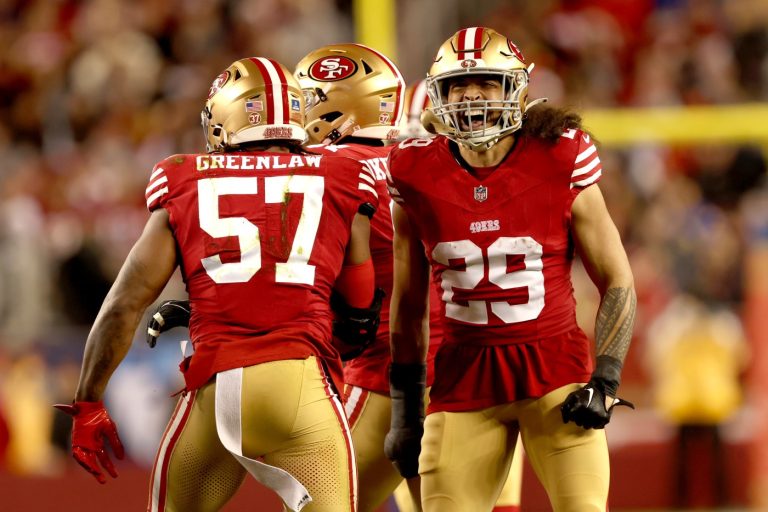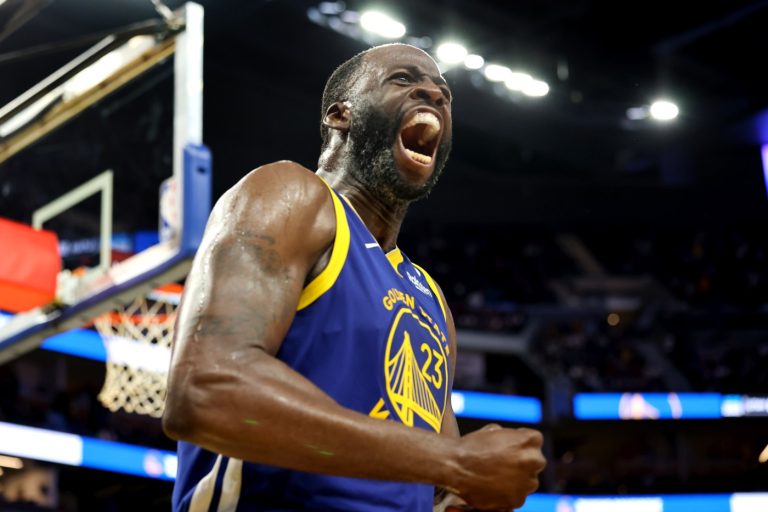The Hotline mailbag publishes weekly. Send questions to wilnerhotline@bayareanewsgroup.com and include ‘mailbag’ in the subject line. Or hit me on Twitter/X: @WilnerHotline
Please note: Some questions have been edited for clarity and brevity.
Would it have made more sense for the Pac-12 to merge with the Mountain West and use unequal revenue sharing? Just pay more to the bigger brands. — @NateJones2009
Generally speaking, very little in the realignment world makes sense. But yes, an outright merger between the two-school Pac-12 (Washington State and Oregon State) and the 12-school Mountain West seemed logical on several levels, particularly if the combined conference kept the Pac-12 name — it has more value and resonance nationally than the Mountain West name.
There were at least two reasons the merger didn’t happen:
— Washington State and Oregon State were deeply frustrated by the Mountain West’s hardline negotiating stance as they arranged a scheduling agreement for the 2024 season and then discussed extending the deal for 2025.
We assume the Mountain West’s strategy was based on the wishes of the majority of the presidents, but it backfired, according to multiple sources familiar with the Pac-12’s position.
— The top teams in the Mountain West wanted to disassociate from the bottom teams, which is the timeless story of realignment: The more valuable schools leave the less valuable schools behind (e.g., Texas and Oklahoma to the SEC).
Yes, revenue generation was at the root of the move. The schools that departed for the Pac-12 in the first wave (Boise State, Colorado State, Fresno State and San Diego State) were the best football brands and generated the largest TV audiences. Any media deal encompassing the entire league would naturally have resulted in the top schools subsidizing the bottom schools.
An unequal-share model might have solved the revenue problem, if not entirely then partially, and the Hotline hasn’t confirmed how seriously that was ever discussed by the Mountain West’s governing board. But it would not have solved the competitive problem.
The top schools in the Mountain West have their eye on the College Football Playoff, thanks to the automatic bid allocated to the highest-ranked team in the Group of Five. And that’s where the strength-of-schedule issue became a significant hurdle.
The bottom tier of the Mountain West would have weakened the schedule strength of the top teams, potentially undermining their chances to reach the CFP.
In that regard, it was far better to leave the bottom behind, join forces with WSU and OSU and create a smaller, more competitive conference that would fare well with the CFP schedule metrics.
That said, there is one merger that makes sense in the most Machiavellian way possible: The reformed Pac-12 joining forces with the top football schools in the American Athletic Conference to create a 12- or 14-team bicoastal conference, with East and West divisions and each team playing a handful of crossover games.
Consolidating the top Group of Five schools would, in our view, result in more annual media revenue than the reformed Pac-12 and the current AAC will generate as separate entities in coming years. And the conference winner would have been assured of claiming the Group of Five’s playoff spot.
But there are innumerable problems with that concept, beginning with the AAC’s current media deal. It runs into the 2030s, and we need no obvious reason for ESPN to willingly agree to void the contract.
If the media rights deal doesn’t go as expected for the Pac-12, will they opt for a full merger with the Mountain West? — @beamyouupscotty
Although we hesitate to say anything is a non-starter in the realignment game, that scenario seems extremely unlikely.
The reformed Pac-12 and what remains of the Mountain West need media rights agreements beginning in the summer of 2026; the conferences are seeking deals at the same time but can hardly be considered equals.
The Pac-12 has a substantial advantage in every metric used to establish media valuation, which explains why the top schools in the Mountain West agreed to join the reformed Pac-12 in the first place: To consolidate the value.
Even if the Pac-12’s media deal is below expectations by $2 million to $3 million per school per year — and we have no idea where the bar has been set internally or what the outcome will be on the market — the schools will collect more cash than they would by combining with the Mountain West.
The latter will simply drive down the overall price.
Also, as mentioned above, Washington State and Oregon State were irked by the Mountain West’s stance with regard to the scheduling agreement.
With the new makeup of the Pac-12 and Mountain West, what’s your estimate of media market values for each conference? — @BakerMeow
Let’s start with a brief explanation of media values relative to overall conference revenue, because there is a difference.
Every conference relies on three primary revenue sources: media rights contracts (for regular-season broadcasts of football and men’s basketball games); the College Football Playoff deal with ESPN; and NCAA Tournament units, which carry a dollar value rooted in the deal with CBS and Turner.
(The media rights contracts typically have produced roughly two-thirds of the cash, although that could change with the new CFP deal that begins in 2026 and will spin off immense amounts to the SEC and Big Ten.)
Also, let’s offer a baseline: The Mountain West’s existing deal with Fox and CBS, which was announced in early 2020 and runs through the 2025-26 competition year, is worth about $5 million per school on average.
In our view, the depleted Mountain West will be fortunate to duplicate that valuation in the next contract cycle.
Yes, the market for college football has soared, but the conference itself has lost its most valuable schools.
What’s more, the media companies will have a choice: Mountain West or Pac-12. And that isn’t much of a choice.
Meanwhile, the Pac-12 could reasonably expect $10 million per school per year, with the potential to exceed that figure by a few million depending on the complexity of the agreements.
Washington State and Oregon State have solid audience metrics, and the five football schools coming aboard all carried above-average valuations in the Mountain West.
Gonzaga’s value is more difficult to predict because basketball is a secondary player in the sports media world. But the Zags have a proven audience nationally.
The unknown piece? Pac-12 Enterprises, which can produce high-quality games cheaply and thus has value to media partners looking to outsource production (like The CW). It very well could increase the number of media companies interested in partnering with the Pac-12, thereby driving up the price for media rights.
The Mountain West is telling potential additions to expect $4 million to $5 million per school in media rights revenue. Replacing their top-five programs with UTEP seems like much more of a steep downgrade than they are admitting. — @fakepaulblood
We agree. The conference will be fortunate to maintain its current valuation without its largest drivers of audience.
UNLV and Air Force have been cast as the linchpins of the new league, and that’s true from the standpoint of name recognition.
But that’s all relative to the schools remaining. The actual valuation of UNLV and Air Force in tandem is low compared to what was lost.
With the new Pac-12, the Big 12 is shut out of California. While I doubt the legacy members of the Big 12 care, do you see this being a long-term problem for the Arizona and Utah schools? — Cole T
It’s worth watching, but not necessary from a recruiting standpoint. Athletes are following the money — the NIL money — and that issue is unaffected by the Big 12’s lack of presence in California.
Far more interesting, in our opinion, are trends for general-student enrollment.
Will the move into the Big 12 affect the number of applicants from high schools in California? After all, the Arizona schools and Utah rely heavily on California students for their out-of-state pipeline (hello, full-cost tuition), and there’s no better marketing tool in higher education than college football.
We’ll need several years to gain clarity on that issue.
Is there a space where the Pac-12 invites a few more basketball schools to grab new markets? Maybe a Seattle University or USF or Santa Clara? — Patrick H
The Seattle and Bay Area media markets make loads of sense on the surface, but basketball rates low on the valuation scale.
Also, those schools hardly move the needle within their home markets.
We don’t see a scenario in which they would drive enough new revenue to compensate for an additional mouth at the trough of conference distributions.
There’s another reason to consider adding basketball schools: To generate NCAA Tournament bids. Each game played is worth roughly $2 million over time to the participating team’s conference.
It’s easy to envision the Pac-12 adding another basketball school or two, but not the ones you mentioned — they don’t clear the competitive bar.
Grand Canyon makes more sense in that regard, but we have no reason to believe anything is imminent with the Lopes (or any other school that doesn’t play football).
The Pac-12’s priorities are securing a media deal and then finding an eighth full-time member.
Could either the Pac-12 or Mountain West get an extension on the NCAA’s certification deadline? — @BearFlagFan
That possibility cannot be ignored.
Both conferences have seven full-time members, meaning each must add at least one school that participates in football and basketball (and a handful of other sports) by the summer of 2026.
Given the lawless nature of the NCAA, and its proven ability to lose legal challenges, either of the conferences could initiate the process of seeking a waiver.
Would it work? We have no idea.
That said, there is another scenario — one broached by several Hotline sources in recent days:
The NCAA simply abandons the eight-school certification requirement as part of deregulation moves stemming from the House v NCAA lawsuit settlement.
If the NCAA cannot prevent athletes from sharing revenue with their schools, why would it care how many schools compete in a given conference?
With the Pac-12’s emphasis on basketball, is Oregon State coach Wayne Tinkle’s seat getting hotter? — @PDX_JonathanW
No doubt about it.
Even though the reformed league is two years away from competing, the pressure to perform on the hardwood is ramping up.
If the Beavers flounder again this season, we expect a change in Corvallis.
Somewhere in that pile of cash controlled by Oregon State (and Washington State), there’s enough to buy out the remaining years on Tinkle’s contract.
What are the odds Gonzaga brings back football? Any insight into what their payout would be in the new Pac-12 without it? — @hpartlow
The Zags are expected to receive full shares of Pac-12 revenue, according to multiple sources. And that makes perfect sense given the brand value they create.
Related Articles
Inside story of Gonzaga joining Pac-12 (and what happens next)
CFP Week 6 picks ATS: Cal beats Miami while Vandy, Iowa cover as dogs
On media: Cal finally gets its ‘College GameDay’ moment and plans to maximize the recruiting exposure
The Holy Score: Yes, Brigham Young is legit, and the path to the Big 12 title is wide open
Gonzaga joins the Pac-12: How the move changes the realignment dynamics for the conference
(Gonzaga basketball and Boise State football will be the most recognizable teams, by far, in the reconstituted conference.)
But we see no scenario — none, zero, zip — that prompts the school to bring back a football program that was dropped in the early years of World War II.
The cost is immense and will increase substantially (for everyone) because of the revenue-sharing model expected to be implemented next year. Also, a football program would siphon resources away from Gonzaga basketball.
In fact, some believe the Zags possess an advantage over their peers in the power conferences.
By not having to pay football players $15 million (approximately), Gonzaga can focus resources, and NIL efforts, on constructing a first-rate basketball roster.
How weird has this college football season been to you without the old traditional Pac-12? — @MrEd315
Thanks for asking.
It has been a bit different, albeit not in a good or bad way.
What has been weird … really weird … is the off-the-field situation: This is the first time realignment has unfolded during the football season.
Texas and Oklahoma to the SEC, USC and UCLA to the Big Ten, the breakup of the Pac-12 — those events took place in the dead of summer.
Covering Pac-12 expansion while the season unfolds has been challenging from a workload perspective.
*** Send suggestions, comments and tips (confidentiality guaranteed) to wilnerhotline@bayareanewsgroup.com or call 408-920-5716
*** Follow me on Twitter/X: @WilnerHotline












